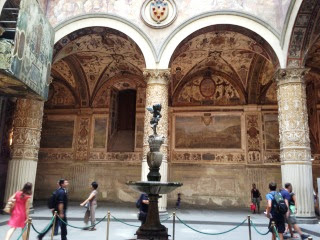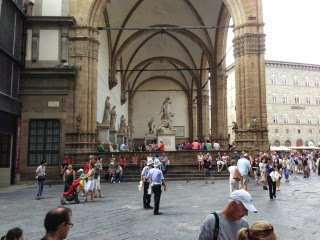In our second assault on Florence, four days after the first, we were once again successful in finding a free car park in Piazza Michelangelo.
So here is the racey yellow car (now with a dint and two scratches) and Michelangelo's David - both in the same photo.
There is quite a lot of parking available for cars, as well as spots reserved for the Hop-on Hop-off bus (the red one) and the Tourist Train. In addition, a lot of the bus tours using those gigantic coaches come up here, giving their passengers 10 minutes to see the view before moving on.
Having booked our tickets online and waited four days for our turn to come, we are once again at the Galleria degli Uffizi. We have to collect our tickets at least an hour prior to our allotted time, which is 3.45pm.
The front facade of the Uffizi faces the river Arno, next to the Ponte Vecchio. It is a U shaped building, so behind this facade, which is the short side of the U, there are two long wings with a courtyard between.
Here they are, two beautifully colonnaded galeries of grey stone. We have collected our tickets from the pre-booked ticket office - queue of three only - and now we have a bit over an hour to fill before our allotted viewing time.
It is only a few steps to the Piazza della Signoria and I jostle the other photographers on the steps of the Palazzo Vecchio, just behind David's left arm, looking out on to the square. The Loggia dei Lanzi is on the left of this photo.
Turning behind me, we step into the Palazzo Vecchio. Originally, on this exact spot, stood the ancient Roman theatre of Florence when this was but a colony of Rome. On those Roman foundations a medieval fortress was constructed in 1299 which in turn became these highly decorative chambers of civic power in the Renaissance.
We didn't go into the museum of the palazzo where we could have seen the magnificent public rooms/chambers decorated by da Vinci, Michelangelo, Vasari and Donatello.
Looking at the Palazzo Vecchio from across the Piazza della Signoria with the Loggia dei Lanzi on the right. You can see a copy of the statue of David outside the entrance and the huge statue of Hercules on the left of the building. This piazza has been the centre of political life in Florence since the 14th century. It has been the scene of great triumphs such as the return of the Medicis from exile in 1530 and the Bonfire of the Vanities, burnings at the stake, in the 1490s.
The sculptures in Piazza della Signoria bristle
with political connotations, many of which are fiercely contradictory. The
David (the original is in the Galleria dell'Accademia) by Michelangelo was
placed outside the Palazzo Vecchio as a symbol of the Republic's defiance of
the tyrannical Medici. Bandinelli's Hercules and Cacus (1534) to the right of
the David was appropriated by the Medici to show their physical power after
their return from exile. The Nettuno (1575) by Ammannati celebrates the
Medici's maritime ambitions and Giambologna's equestrian statue of Duke Cosimo
I (1595) is an elegant portrait of the man who brought all of Tuscany under
Medici military rule.
It cost 70 euros to ride around the city centre in this horse drawn vehicle.
Circling the square again, on our way back to the Uffizi, it seems that the crowd has thinned somewhat and I can actually see the statues in the Loggia dei Lanzi. Built in 1376, this is an outdoor sculpture gallery which includes Perseo with the Head of Medusa and The Rape of the Sabines, both stark reminders of the power of the Medici.
Finally it is our turn at the Uffizi - I thought you might like this extract:
Like a very precious treasure, the Uffizi Gallery will grant itself to visitors only after some initial trials: uncertainty as to where to get tickets, lines to get tickets, varying 'official' prices for tickets, lines to get inside, lines at the metal detector, lines at the audioguides, many, many stairs before the access to the top loggia and then finally, the Gallery will unveil its stunning frescoed ceilings and a long labyrinth of amazing works of art exposed chronologically. This “U” shaped Renaissance building was actually not created as a museum. Cosimo de’ Medici had entrusted his favorite architect Giorgio Vasari to create a grandiose building to house the seats of the Florentine Guilds (the magistrates), a vast theatre and judiciary offices (hence the name “Uffizi” which means offices in Italian).
For this reason, the spaces you’ll be visiting were not meant to welcome up to 10,000 people a day in air conditioned comfort. The halls of the Uffizi were only accessible to the Grand Ducal family, servants and a few selected guests. Guests were welcomed on the top floor of the Uffizi to admire the grandiose collection of Roman sculptures. The Medicis collected art for centuries - manuscripts, sculptures, paintings, gems, coins, cameos and more. Francesco I,commissioned the first private room dedicated to “any kind of wonder”. Buontalenti created for him an octagonal shaped Tribune to host Francesco’s favorite works of art and jewels. The Tribune is considered the most ancient and precious heart of the Uffizi, still maintaining the original shape of its 1584 construction. The concept of “museum” was developed later by Pieter Leopold of the Lorraines in 1769, when he opened the Uffizi and its treasures to the public. He would have never imagined that it would become one of the most frequented museums in the world. Serious art lovers should visit the Uffizi at least twice to see all of it!
The first of the three arms of the upper gallery
Looking down on the courtyard flanked by the two long arms of the U.
The section of gallery that faces the river Arno - looking in one direction .....
... and then in the other.
Looking across the U shape at top floor level. The top floor has limited air-conditioning, and is cooled by opening the windows, as you can see here. The whole structure seems in need of repair but given the money they are collecting from the tourists, they will have a healthy budget.
Photos were only allowed in these three long corridors of the top floor. No photos of the art works were permitted. But it is as much the building as the art that is the attraction.


















No comments:
Post a Comment